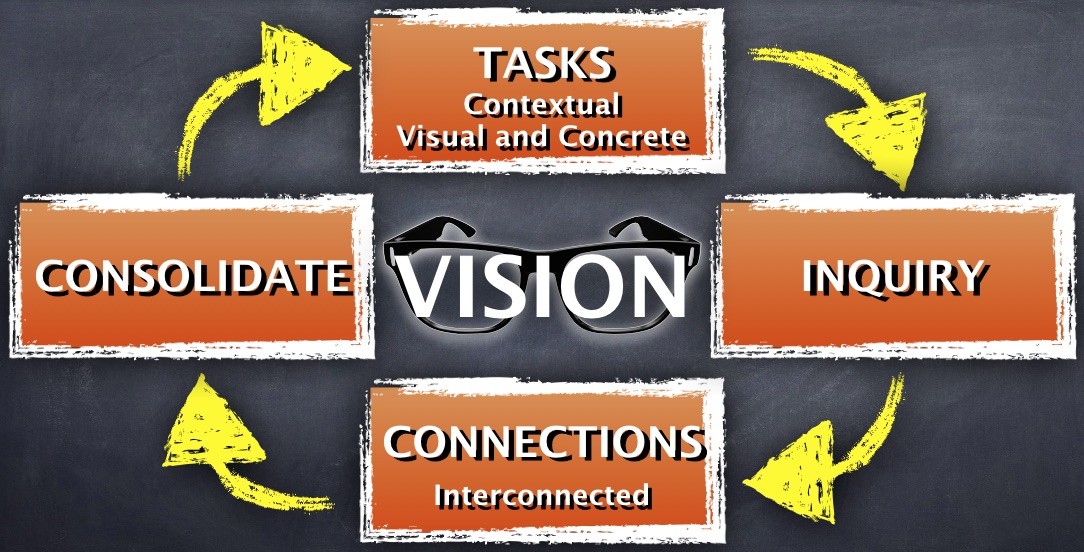Which Is Best: Inquiry or Explicit Instruction?
The ongoing debate over whether math concepts should be taught using a discovery approach versus explicit instruction has been going on for years. These “math wars” (see examples here and here) typically paint effective instruction in mathematics as an either/or situation between the two extremes. Some might interpret inquiry based instruction as necessary to construct conceptual understanding prior to committing algorithms to memory, whereas others might conversely interpret explicit instruction as the requirement to first build procedural fluency necessary to enable a student to better understand why a formula works later. Regardless of where you stand on the continuum, Dr. Daniel Ansari does an excellent job in this video discussing why these math wars between inquiry based learning and explicit instruction should end.
While I have personally stood on both sides of this war – early in my career using heavy doses of explicit instruction and most recently serving up an almost complete inquiry-based approach – only now am I able to see that neither extreme is appropriate. Some mathematical concepts are likely best suited for a direct instruction delivery, while others may seem more natural to introduce from a discovery standpoint. More importantly, I think the decision as to which topics are taught from different teaching styles could and should be different based on the unique characteristics of the educator such as: personality, teaching style, and their own interpretation or understanding of the specific learning goal.
Starting With Inquiry and Moving to Explicit Instruction
With that said, I will be honest in saying that I almost always prefer when I can find an interesting way to introduce a task from an inquiry approach. Unfortunately, teacher interpretation of what an inquiry math lesson looks like varies drastically. According to E. Lee May, from Salisbury State University, the definition of an inquiry based math lesson is:
…a method of instruction that places the student, the subject, and their interaction at the center of the learning experience. At the same time, it transforms the role of the teacher from that of dispensing knowledge to one of facilitating learning. It repositions him or her, physically, from the front and center of the classroom to someplace in the middle or back of it, as it subtly yet significantly increases his or her involvement in the thought-processes of the students.
As cited on inquirybasedlearning.org
This leaves many different possibilities for lesson ideas to be defined as “inquiry”. For me, I keep a 4-part math lesson in mind when planning.
4-Part Math Lesson Framework:
- Begin with a 3 Act Math Task or another method to spark curiosity;
- Use an inquiry-based approach to solve the initial problem;
- Implicitly or explicitly make connections to ensure all students have the conceptual fluency related to the new learning goal; and,
- Explicitly consolidate the new learning by moving towards the necessary procedural fluency related to the new learning goal.

While I always attempt using the 4-part math lesson framework when possible, it is not always easily achievable, necessary, or appropriate for every concept. Currently, I do not have every lesson planned using this framework, but I am always trying to think of ways to use this approach to improve my lessons, where possible.
So regardless of whether you feel that you sit more on one side than the other, consider exploring ways to use inquiry and explicit instruction where appropriate in your classroom. A good place to start might be trying to structure a 4-part math lesson or just exploring some 3 act math tasks by Dan Meyer and others from around the web. Here are a couple tasks I’ve created that do some of the heavy lifting for the first two parts of the lesson such as Walk-Out, Stacking Paper Tasks, and Tech Weigh In.
If you have explored using a 4-part math lesson, please feel free to share your reflections in the comments section.

Reflection
The ideas and exploring different approaches together will help students see how their own reasoning connects to concepts like linear relationships and slope. This way, they will experience how curiosity and structure can work hand in hand. Some issues to reflect on What felt exciting about today’s task? What made you see math in a new way? This closing reflection encourages students to think about their own thinking, while fostering an atmosphere of openness and joy. By blending inquiry with clear guidance, I want students to feel that our classroom is a space where thinking is valued, mistakes are part of learning, and we’re all in this journey together.